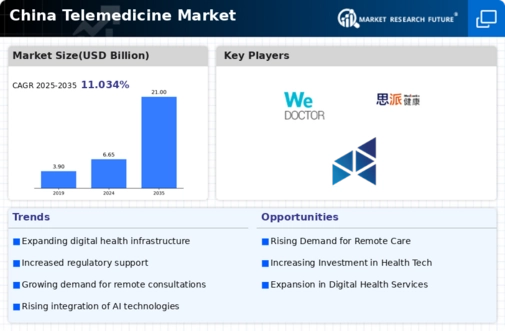Rising Healthcare Costs
Rising healthcare costs in China are prompting both patients and providers to explore more cost-effective solutions, thereby impacting the telemedicine market. With healthcare expenditures increasing at an annual rate of 10%, many patients are seeking alternatives to traditional in-person visits. Telemedicine offers a more affordable option, reducing travel expenses and time away from work. Moreover, healthcare providers are recognizing the potential for telemedicine to lower operational costs while maintaining quality care. This shift towards cost efficiency is likely to drive the adoption of telemedicine services, as both patients and providers seek to mitigate the financial burdens associated with healthcare.
Growing Focus on Preventive Care
The telemedicine market in China is increasingly aligned with a growing focus on preventive care. As healthcare systems evolve, there is a shift towards proactive health management rather than reactive treatment. Telemedicine facilitates regular check-ups and health monitoring, allowing patients to engage in preventive measures from the comfort of their homes. This trend is particularly relevant in managing chronic conditions, where early intervention can significantly improve outcomes. In 2025, it is projected that telemedicine services will account for 25% of all preventive care consultations in urban areas. This emphasis on preventive care not only enhances patient health but also reduces the overall burden on healthcare systems, thereby supporting the growth of the telemedicine market.
Government Support and Regulation
The telemedicine market in China benefits from robust government support and regulatory frameworks. The Chinese government has implemented policies aimed at promoting digital health solutions, which include telemedicine services. This support is evident in the allocation of funding and resources to enhance telehealth infrastructure. In 2023, the government announced a budget increase of 15% for health technology initiatives, which directly impacts the telemedicine market. Furthermore, regulations that streamline the approval process for telemedicine services encourage healthcare providers to adopt these technologies. This regulatory environment fosters innovation and ensures that telemedicine services meet safety and quality standards, thereby enhancing public trust in these solutions.
Increased Demand for Remote Healthcare
The telemedicine market in China is experiencing a surge in demand for remote healthcare services. Factors such as an aging population and the rising prevalence of chronic diseases contribute to this trend. According to recent statistics, approximately 30% of the Chinese population is over 60 years old, leading to a greater need for accessible healthcare solutions. Telemedicine offers a viable alternative for patients who may have difficulty traveling to healthcare facilities. This demand is further amplified by urbanization, as more individuals seek convenient healthcare options. As a result, healthcare providers are increasingly investing in telemedicine technologies to meet the growing needs of patients, thereby driving the market forward.
Technological Advancements in Communication
Technological advancements in communication are significantly influencing the telemedicine market in China. The proliferation of high-speed internet and mobile connectivity has made it easier for healthcare providers to offer telehealth services. In 2025, it is estimated that over 80% of urban areas in China will have access to 5G networks, which enhances the quality and reliability of telemedicine consultations. These advancements facilitate real-time communication between patients and healthcare professionals, improving the overall patient experience. Additionally, the integration of secure platforms for data exchange ensures patient confidentiality, which is crucial for the acceptance of telemedicine services. As technology continues to evolve, it is likely that the telemedicine market will expand further, driven by enhanced communication capabilities.














Leave a Comment